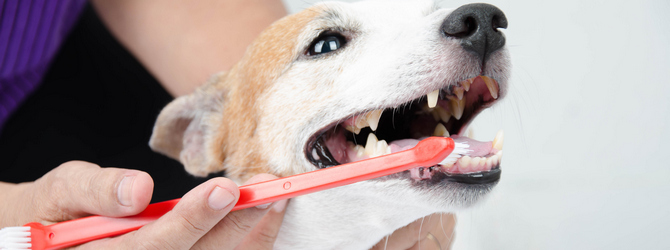Dog teeth cleaning: how to clean dogs teeth
Dental care is very important in dogs and their teeth require regular cleaning to prevent the build up of plaque and tartar, and the onset of gingivitis in dogs. Our vets recommend brushing your dog's teeth at least two to four times a week, but preferably daily. Studies show that fewer than 2% of dog owners clean their dog's teeth every day even though it's proven to be the most effective way to prevent dental problems and bad breath.
Guide on how to clean dog teeth
Not sure how to start brushing your dog's teeth? We’ve got you covered. Simply read our three-step guide or check out our helpful video below:
- Step 1: Start by using your finger to brush the side of your pet’s face by his mouth. Then progress to brushing the actual teeth, just using your finger. Once he is used to this, start using a small amount of animal toothpaste on your finger and gently rub it along the teeth.
- Step 2: Progress to using an actual toothbrush. You can use any toothbrush, but ones designed for veterinary use come in different shapes and sizes, which makes them a bit easier to use on pets.
- Step 3: You should eventually aim to brush all the surfaces in about two minutes. The more gradual the process, the easier it will be.
Why should I clean my dog's teeth?
Dog teeth cleaning is the most effective way to prevent them from developing oral health problems. Brushing your dog's teeth regularly lowers the risk of gingivitis and periodontitis, and many more dental-related illnesses.
Regular brushing will not only help to keep your dog's mouth clean and healthy, but taking preventative action could also save money in the long run by reducing the need for expensive veterinary dental procedures.
Keeping on top of your pet's dental needs and maintaining good oral hygiene should be as much a part of your dog's life as it is yours.
How often should I brush my dog's teeth?
To maintain healthy teeth and gums, we recommend that you brush your pet’s teeth at least 2-4 times a week. But for best results, brush their teeth every day — the cleaner their teeth are, the lower the risk of developing dental diseases such as gingivitis in dogs.
Regular tooth brushing helps to remove plaque and combat bad breath. If plaque builds up on your pet’s teeth, it can become hardened plaque, which only your vet can remove.
How to maintain healthy teeth in dogs
Alongside regular dog teeth cleaning, to maintain healthy teeth and gums you should feed your pet a nutritious balanced diet. Here are three diet tips that will keep your pet smiling.
Use a dental diet: Some dry pet foods are specially designed to keep your pet’s teeth clean by scraping away plaque as they eat. Speak to your vet about the best and most reliable dental diets for your pet.
Dental chews and treats: These also work by scraping plaque from your pet’s teeth — most chews and treats contain lots of calories so it’s best to use them sparingly.
Avoid human snacks: Human treats are meant for humans, not pets. By all means treat your pet, but only use appropriate foods and be careful not to overdo it.
Visit the vet regularly: Regular dental checks are a must. It's worth noting that Pet Health Club members receive six-monthly dental check-ups and 10% off dental procedures as part of their membership benefits.
Need more advice on how to clean dogs teeth?
For expert advice on dog teeth cleaning, get in touch with your local vet.
Find your nearest vet using our find a vet page, or speak to a vet online using online vets.
You can view our canine dental care range here or visit our dog dental health hub for more helpful videos, infographics and advice.



